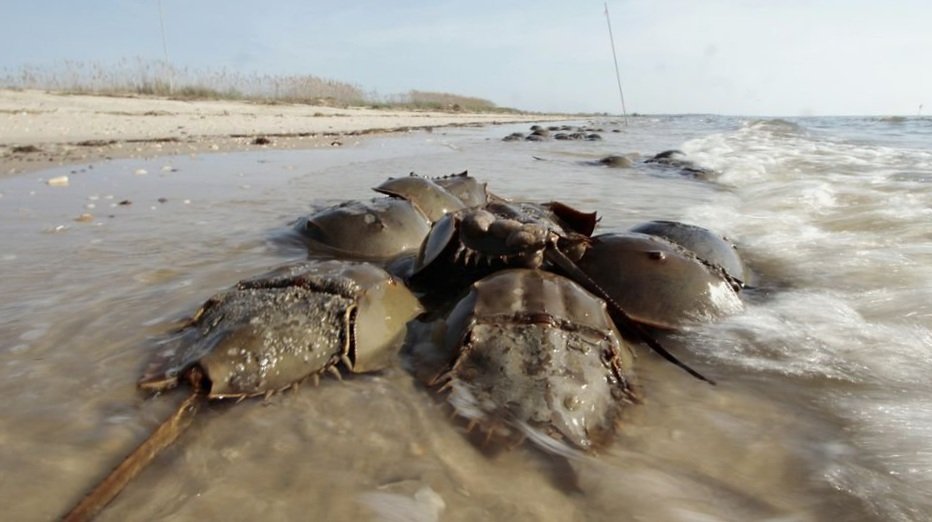
Horseshoe Crabs
The Atlantic Horseshoe Crab
Limulus polyphemus
Horseshoe crabs evolved over 450 million years ago. That’s 200 million years before the first dinosaurs, giving them the nickname, "Living Fossils." Today, there are only 4 living species of horseshoe crabs, grouped into their own unique Class, Merostomata.
As Arthropods, they have hard exoskeletons and must molt as they grow. Horseshoe crabs are not "true" crabs at all, in fact they are most closely related to scorpions and spiders. Yet, they are some of the most gentle creatures to find at the beach.
Their tail, or telson, is not dangerous and is necessary for righting themselves if they get tossed in a wave. Avoid picking them up by the tail!
female
male
Life Cycle + Reproduction
Found along the East Coast of the US from Maine to Florida, Atlantic Horseshoe Crabs spend the winter months in deeper ocean waters. In the spring, they migrate back into bays and estuaries to reproduce. Following the highest high tides, created by the gravitational pull of the Full and New Moons, they aggregate on shore by the 1000s to lay their eggs, buried in the sand. In the first year of life, juveniles will molt 7 or 8 times, then once a year after that. Males reach sexual maturity around 8 years old. On their final molt their front appendages transform into rounded hooks for grasping onto the back of the female’s shell. The much larger females mature closer to 10 years old. The maximum age of adult horseshoe crabs is still a mystery!
Importance
Ecological
A single female will lay about 80,000 eggs each mating season. These hundreds of millions of horseshoe crab eggs serve as an essential link in the coastal food chain, providing energy for migrating shorebirds, like the threatened Eastern Redknot.
Horseshoe crabs and Humans
Humans harvest horseshoe crabs, both for use as bait and most notably our biomedical industry relies on special compounds in horseshoe crab blood for detecting gram negative bacteria. This special copper-based, blue-green blood allows for the safe production of every medical device or treatment entering the human body, including vaccines, pace makers, and joint replacements.
Horseshoe crabs bled alive at a facility in Charleston, S.C., in June 2014. Ariane Müller
Conservation
Tiana Bayside Horseshoe Crab Monitoring Site
In 2019, Back to the Bays helped establish and continues to manage the Tiana Bayside Horseshoe Crab Site. This site is part of the New York Horseshoe Crab Monitoring Network, a joint effort with CCE Marine Program, Stony Brook University, and the DEC to tag and count horseshoe crabs, with the help of volunteer citizen scientists. Data collected helps inform policy that can help protect this important population for generations to come.
This site is part of our Hampton Bays (Tiana) Stewardship Site.
Site coordinator, Danielle Morris, dm733@cornell.edu
Gabion Removal + Living Shoreline Proposal
CCE Marine is working with the Town of Southampton on a long-term plan to revitalize a portion of Tiana’s shoreline. A man-made gabion structure, which poses a dangerous hazard to humans and prevents horseshoe crabs from returning to the bay, will be replaced with native grass and oyster reef habitats.
In the short term, we need interested local volunteers on stand-by during spawning season (May-July) to help us rescue horseshoe crabs that become stuck on the wrong side of the gabions at low tide. If you are interested in helping, please email Volunteer Coordinator, Hazel Wodehouse, at hew57@cornell.edu.
What can you do?
Educate yourself and others about the importance of horseshoe crabs and how to safely handle them. Remember, never pick them up by the tail. Try not to separate mating pairs. It is normal for them to burrow in the sand and wait for high tide, but if you see a barrier preventing one from returning to the water, gently lift them by the carapace (the horseshoe shaped part!) and place them in shallow water facing out.
Report any tags you find to help us track their population. You’ll receive a certificate and a pin!
Volunteer at a horseshoe crab monitoring site.
Donate
Support our Tiana Bayside Horseshoe Crab Monitoring Site
NEW! Adopt a Horseshoe Crab
Protect + monitor local Horseshoe Crabs!
$50 or $100 ~ Support public education + awareness to protect Horseshoe Crabs
Horseshoe Crabs lay millions of eggs along the shore, providing an essential link in the coastal food web. Their blood is a vital component in biomedical safety procedures. Back to the Bays helps manage the NY DEC’s monitoring + tagging efforts at Tiana Bayside Facility, in Hampton Bays. Your support helps us provide outreach and awareness of this important species.
Learn more about Species Adoptions












